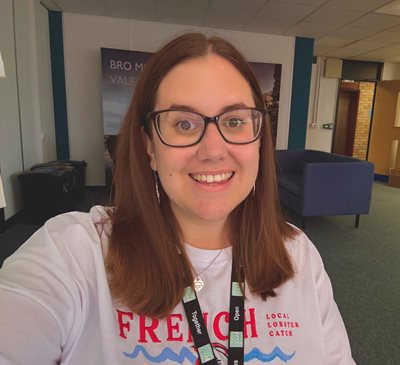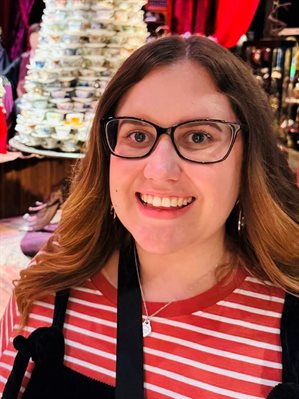Staffnet+ >
Finding Pride - Deafness and the Power of Visibility
Finding Pride: Deafness and the Power of Visibility
14 July 2025
Each July, Disability Pride Month offers a moment to be seen - not as an inspiration or a tragedy, but just as unapologetically human.
 For me, pride is layered. I’m hard of hearing, living in the shifting space between claiming my deaf identity, yet being seen on the surface as a fully hearing person. I’ve spent my life walking the tightrope between the Deaf and hearing worlds, learning to adapt to both while never fully feeling rooted in either.
For me, pride is layered. I’m hard of hearing, living in the shifting space between claiming my deaf identity, yet being seen on the surface as a fully hearing person. I’ve spent my life walking the tightrope between the Deaf and hearing worlds, learning to adapt to both while never fully feeling rooted in either.
I was born with a condition called Congenital Cytomegalovirus (CMV).
CMV is a viral infection that occurs when a baby is infected with the cytomegalovirus before birth. It’s actually one of the most common congenital infections, but not many people have heard of it. For some babies, CMV causes no symptoms at all - but in others, like me, it can lead to long-term health challenges.
Shortly after being born, I became very poorly very quickly due to the infection which led to two brain haemorrhages, and caused catastrophic damage to my auditory nerves in my brain. Today I am completely deaf in my right ear, with only partial hearing in my left ear.
On the surface, I’ve always been confident, bubbly, and chatty — the kind of person who thrives on conversation and connection. I grew up in a hearing family with no ties to the Deaf community, I didn’t have noticeable speech differences, and I navigated the hearing world with confidence. Somewhat ironically, in my years before joining the Council, I worked as a Radio Journalist at the BBC – a role that demanded sharp listening skills and constant engagement with sound, even though I was hard of hearing.
But beneath that lively exterior was a constant struggle. Social situations often felt like a minefield - I missed bits of conversations with friends at school and in classrooms, and when I ask people to repeat themselves, they often say “never mind.”
As an adult, I learned to smile and nod along during group conversations, even when I had no idea what was being said — not wanting to be a burden or spoil the mood. Living this way meant carrying the quiet weight of feeling unseen and unheard. I would often come home from work exhausted from concentrating so hard all day on what people were saying and reading lips – this I now know as hearing fatigue.
Deafness is a non-visible disability, and I often felt that because my own hearing loss could not be seen, I didn’t feel like it was worth it to advocate for myself. I was told as a child that hearing aids wouldn’t benefit me due to my specific type of hearing loss – and the single-sided cochlear implants weren’t a readily-available option in the late 1990’s when I was a child. My only connection to Deaf culture growing up was seeing Mr Tumble’s use of sign language on TV.
So, I learned to just accept my reality — to carry on, to adapt and just do my best.
But during the lockdowns of the Covid-19 pandemic, something changed. The pandemic was difficult for many reasons – meetings had moved online instead of being face-to-face, and everyone was wearing masks, which made it almost impossible to make out what people were saying.
I, along with many people during that time, was also chronically online and would endlessly scroll TikTok to fill the hours being stuck inside. I started to have videos pop up on my feed from other Deaf and hard of hearing people talking about how they were coping with the new normal of the time, and how they were advocating for themselves. At the same time, more and more people were starting to use the Sunflower lanyards in public settings as a way to let others know that they had a hidden disability.
 For me, this felt radical and liberating at the same time. People became more aware of some of the barriers that disabled people faced when doing something as simple as going to the supermarket – and more people were advocating for themselves and for better access for all.
For me, this felt radical and liberating at the same time. People became more aware of some of the barriers that disabled people faced when doing something as simple as going to the supermarket – and more people were advocating for themselves and for better access for all.
I felt emboldened by this and started to advocate more for myself too. I had the confidence to ask for better adjustments at work and I reached out to my GP to explore if there were any more aids and tools that I could use. Because of this, I found out that there were new developments in hearing aid technology and was fitted with a special type of hearing aid that would use Bluetooth to pick up sound from my ‘deaf side’ and channel it over wirelessly to my better ear.
I began sharing with friends and family what life had felt like all these years, and how I had felt isolated at times. This in turn inspired some of my family members to begin learning sign-language so that they could be better allies to other people living with hearing loss.
For most of my life, I felt like I had to quietly adapt, to minimise my needs so I wouldn’t disrupt the flow of the hearing world around me.
But learning to advocate for myself, embracing the tools that support me, and connecting with others who share similar experiences, helped me realise that I don’t have to walk the tightrope alone. I now take pride in the identity I once kept quiet. Being hard of hearing isn’t something I need to hide or overcome - it’s simply a part of who I am. And in claiming that, I’ve found a louder, prouder voice than I ever thought possible.
By Hollie Smith, News and Media Intern